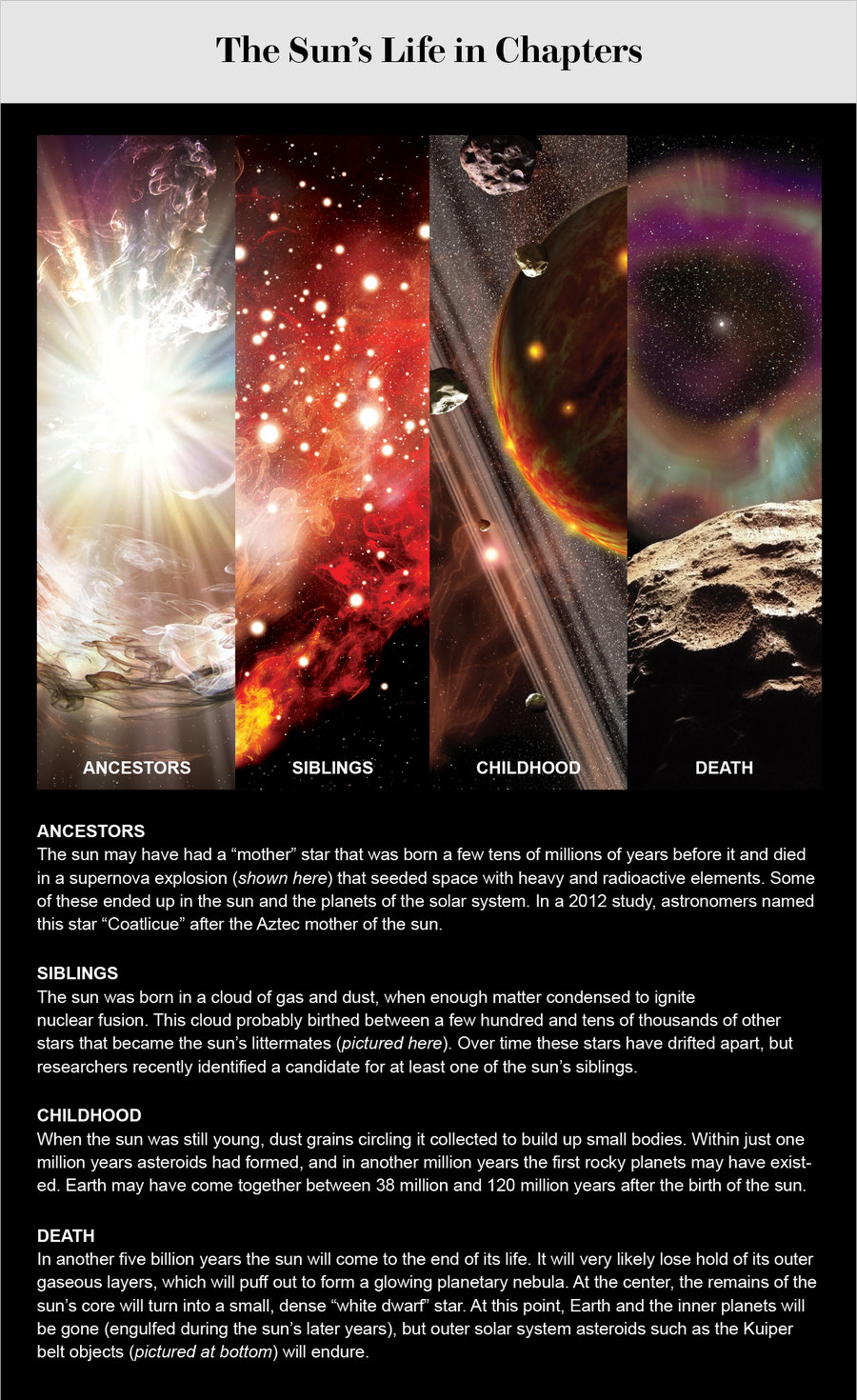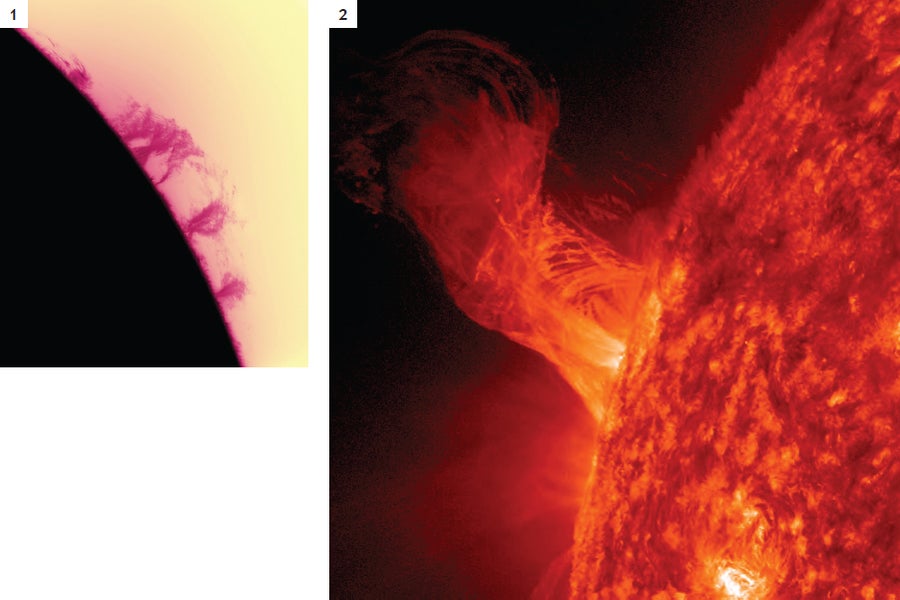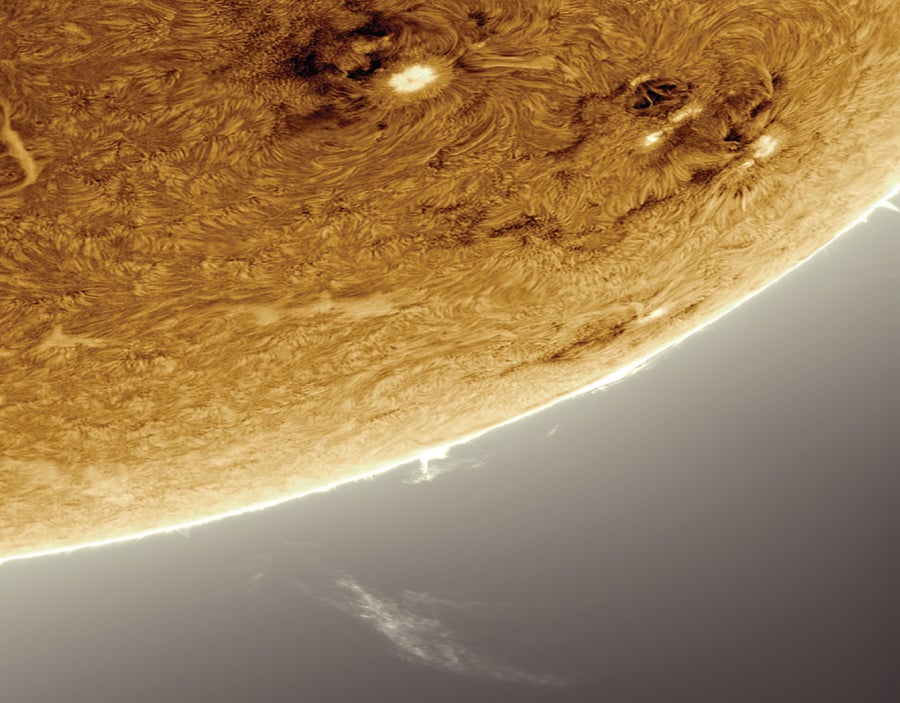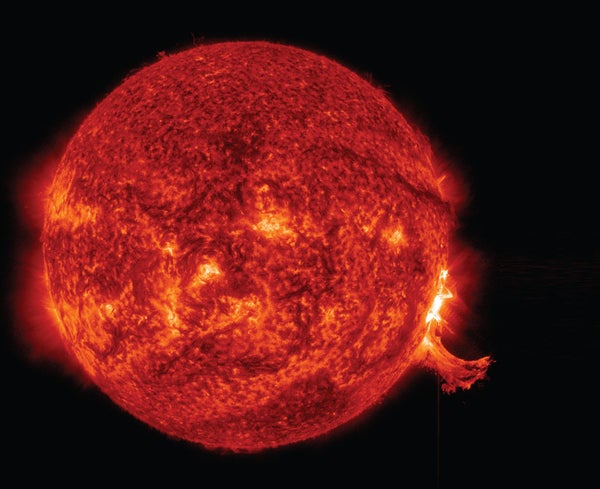In the beginning, there was nothing but cold and dark between the atoms that became the solar system. No sun existed 4.6 billion years ago, only a gossamer cloud of remains from earlier stars, stocked with elements forged in previous cataclysms beyond our comprehension. And then something happened.
Maybe a passing celestial nomad's gravity nudged the cloud; maybe a more distant star exploded, loosing a wind that ruffled the atoms, just as a breeze can push leaves into a pile. In any event, the atoms gathered together and began to condense, until finally the material grew hot enough to begin fusing hydrogen into helium. The sun was born, and, not long afterward, so was Earth. Less than a billion years after that, the first life arose, at least on this planet—and now here we are.
This basic story is what science has told for decades: solar birth, a boring stretch of time and then genesis. But powerful new space telescopes and the burgeoning field of “cosmochemistry,” as well as genealogy techniques borrowed from biology, are enabling astronomers to write a much richer and more complex biography for the sun. Today scientists know our star was not always solitary. It once had siblings, and it may have even adopted one of their planets. The sun and its planets had, for lack of a less anthropomorphic word, a mother: a giant star whose short life provided the embryonic material for the solar system. This precursor material might have been isolated from the rest of the galaxy for at least 30 million years, a lengthy gestation that belies the speed at which the sun made planets.
On supporting science journalism
If you're enjoying this article, consider supporting our award-winning journalism by subscribing. By purchasing a subscription you are helping to ensure the future of impactful stories about the discoveries and ideas shaping our world today.
Even the sun's eventual death is coming into new relief. Astronomers know that in about five billion years, it will burn through its hydrogen supply and begin to cool, ballooning into a swollen behemoth whose outer edges might swallow our planet. But they are still learning how the sun's death rattle will influence the interstellar medium (the gas and dust that fills the space between stars), the makeup of future stars and the galaxy as a whole. It is possible that, in death, the sun will become a “mother” itself, enabling new stars and possibly new planets to form.
And in learning more about the sun's past, present and future, scientists are doing more than just writing our own history. The universe may have innumerable stars, but we can know only one intimately. Every insight we glean casts light on the many distant orbs that we will never come to understand so well.
Before The Sun: Solar Ancestors
Millions of years before the sun ignited, before it was a glimmer in the eye of the Milky Way, its ancestors dominated the galactic neighborhood. These earlier stars were themselves the many-times-great-grandkids of the galaxy's first stars, and their generation numbered in the tens of thousands. Within a few million years of their own formation, some of them began to die. Their violent deaths seeded the galactic region with its first heavy elements, such as iron and aluminum. The remnants of these stars gave rise to later generations of stars, including the forebears of the sun.
Astronomers are reconstructing this history using meteorites, leftover crumbs from the birth of the solar system. Researchers compare the amounts of various radioactive isotopes in the meteorites with those in the galaxy's interstellar medium, which is constantly replenished by celestial death throes. The differing abundance of these radioactive materials, which diminish over specific timescales, serves as a clock for astronomers seeking to determine when the solar system's building blocks were finally present.
By following one radioisotope, aluminum 26, Matthieu Gounelle of the French National Museum of Natural History and Georges Meynet of the Geneva Observatory traced the sun's family tree back three generations. Aluminum 26 is radioactive, with a half-life of about 730,000 years—meaning half of any given sample will decay over that time. It is found in meteorites dating to the earliest days of the solar system, and many astronomers assume it originated in a supernova that could have exploded near the sun when it was forming. But a supernova to mark the occasion of the solar system's birth would have been an unusual coincidence. Instead in 2012 and later Gounelle and Meynet showed that the aluminum 26 could have formed inside a massive star.

Credit: Ron Miller
This star would have been the most massive in our cosmic corner, about 30 times the mass of the sun, according to Gounelle and Meynet's calculations. Like other gargantuan stars, it would have lived a short but spectacular life, exploding a few million years after it ignited. It would have not only synthesized the aluminum 26 but also, in its violent death by supernova, streamed hydrogen gas, heavy metals and radioactive elements into the cloud of gas that would become the solar system. The researchers named this star “Coatlicue,” for the mother of the sun in Aztec cosmogony.
Research has provided further clues about how the solar system's building blocks came to be. In 2014, for instance, scientists in Australia showed that some of the heavy metals, such as gold, silver and platinum on Earth and in meteorites, arrived in the neighborhood some 100 million years before the birth of the sun. A portion of the rare earth elements, such as neodymium, arrived in the sun's gestational environment some 30 million years before it formed. The sun therefore incubated for a lengthy period, with an upper limit of 30 million years.
Although astronomers cannot travel back in time to verify this story, they can compare it against other planetary systems with similar chemical compositions, says Megan Bedell, an astrophysicist at the Flatiron Institute in New York City. And the time line appears consistent. “We are putting the sun in context with its neighbors and seeing that it is a pretty typical star for its formation conditions,” she says.

SOLAR PROMINENCES rise from the sun's face in these photographs from 2013 (1) and 2012 (2). The eruptions extend about 30,000 and 160,000 miles from the sun's surface, respectively. Credit: Alan Friedman (1); NASA's Solar Dynamics Observatory and AIA, EVE and HMI science teams (2)
In addition to tracking the sun's forebears, scientists are also using tools from biology to look for its cousins, uncles and other relatives—its broader family tree. Whereas a botanist might use DNA or inherited traits to relate one species of plant to another, astronomers study the ratios of chemical elements in different stars to investigate the relations among them. Didier Fraix-Burnet, an astronomer now at the Institute of Planetology and Astrophysics of Grenoble in France, was one of the first to propose this technique in 2001. He dubbed it “astrocladistics,” after cladistics, a term biologists use to describe the technique of mapping inherited traits. Last year Paula Jofré of Diego Portales University in Chile and her colleagues used this method to construct a stellar evolutionary tree for the sun's neighborhood.
Working with a University of Cambridge biologist, Jofré's team used a clustering approach from biology called the distance method, which constructs an evolutionary tree where different branches indicate evolutionary change. In astronomy, the branches represent star populations that are separate in age and movement patterns through the galaxy. Imagine two generations of stars. The first generation has two stars—one large and one small. The more massive star will explode earlier and give rise to a second-generation star in the same way that Coatlicue died and birthed the sun. “The second generation is carrying information from the first generation. They are kind of ‘genetically’ connected,” Jofré says. “So you might be finding a star and its uncle.”
Jofré and her colleagues scrutinized 22 nearby stars similar to the sun and focused on 17 chemical elements as a stand-in for DNA to determine “family” relations. Their analysis grouped the stars by elemental ratio and sorted them into two well-known families of stars. They also found some that belong to a new, previously unknown third group, which Jofré says is still mystifying.
A Star and its Siblings are Born
From the birth of Coatlicue and its forebears a few tens of millions of years before the sun formed, things stayed busy in the sun's natal cloud. Gas collapsed and ignited, forming other stars. As they switched on, pressure from their stellar winds and the light they emitted would have pushed nearby gas outward, eventually triggering the birth of even more stars: the sun and its littermates. Estimates of the number of those littermates range from a few hundred to tens of thousands. The truth is probably on the lower end, given the fairly stable alignment of the sun's planets: closer siblings would have perturbed the solar system, altering the number and position of planets inside it.
Although they were born relatively close together, the sun's siblings have long since moved on. Over the eons some blew apart into oblivion, and others drifted apart because of minor differences in the speed with which they rotate around the center of the galaxy. Their current positions are all but impossible to match up with their place of origin. “Much like me and my twin brother, we formed together, but we completely dispersed and did separate things,” says Keith Hawkins, an astronomer at Columbia University. He says chemical tagging, also known as cosmochemistry—such as the technique of comparing the ratios of certain heavy and light elements in stars—allows scientists to see connections between stars that would otherwise be invisible.
.png?w=900)
Sources: “Cosmic Phylogeny: Reconstructing the Chemical History of the Solar Neighbourhood with an Evolutionary Tree,” by Paula Jofré et al., in Monthly Notices of the Royal Astronomical Society, Vol. 467, No. 1; May 11, 2017; Hipparcos Catalogue. European Space Agency, 1997. Illustration by Katie Peek
In 2014 Iván Ramírez went looking for the sun's littermates and found one. Now a professor at Tacoma Community College, Ramírez started with about 30 candidates, which he chose based on their chemical compositions and the speeds and directions that they travel through the Milky Way. After further analysis of these characteristics, he narrowed the field to just one star, called HD 162826. It is about 15 percent more massive than the sun and just a bit bluer, he says. Although the sun and its sibling would have formed close together, today HD 162826 is 110 light-years away in the constellation Hercules. It is visible with a decent pair of low-power binoculars, above Hercules' shoulder and not far from the bright star Vega.
Ramírez says his search was partly born of pure interest, but he also wanted to test strategies that he and others will use when they download a gargantuan galactic data set from the new Gaia satellite. The spacecraft is designed to measure stars' brightness and precise position in the sky and will track a billion stars to produce the most detailed 3-D map ever made of the Milky Way. Its latest batch of data, released in April, includes precise measurements for more than 1.3 billion stars. This number is more than an order of magnitude greater than the previous best data set.
Ramírez thinks Gaia will help astronomers find about half of the sun's lost littermates. In doing so, the survey could tell astronomers about the sun's birth environment and its path since then through the Milky Way. The sun is orbiting the galactic center today at roughly 125 miles per second, and astronomers think it has made at least 20 trips around the galaxy so far.
Childhood: Creation of the Planets
Not long after the sun and its siblings ignited, dust grains around many—if not all—of those stars began coalescing into planets. In our solar system, at least, planet building happened posthaste. Evidence from meteorites suggests that once solid matter condensed, it took less than one million years to form the first generation of asteroids. Largely driven by the decay of aluminum 26, chunks of rock heated up and differentiated into bodies with a metal core and a silicate mantle. Larger rocky worlds were not far behind. Mars may have formed within two million years, according to one estimate. Earth came together between 38 million and 120 million years after the sun did.
Around that time, our star may have captured a planet from a sibling. The putative Planet Nine, a theoretical giant body that astronomers think lurks at the outer edges of the solar system, may be a cousin world, adopted by the sun 100 million years after our star's birth. For such a scenario to have taken place, Planet Nine would have had to orbit its original star at a wide distance, roughly 100 to 500 times the stretch between Earth and the sun (100 to 500 astronomical units). At the same time, this star would have had to swing by the sun, its sibling, at roughly 1,500 times that distance. This type of stellar encounter happens relatively frequently in other star clusters, so astronomers know it is feasible. If Neptune-size planets are common, then many stars are likely to host Planet Nine–type worlds in highly eccentric orbits that make them vulnerable to kidnapping by other stars.
In 2016 Alexander Mustill and Melvyn Davies, both at Lund University in Sweden, and Sean Raymond of the University of Bordeaux in France calculated that the sun could have had several opportunities to snag Planet Nine. It is even possible that the sun grabbed the world without disturbing the Kuiper belt, the ring of comets and asteroids at the solar system's edge.
Further study of the solar system's outer objects will help theorists figure out Planet Nine's parentage—if the rumored planet in fact exists. And if it does, it may not be the only interloper from another star to have jostled or joined the sun's family. In 2015 Eric Mamajek, then at the University of Rochester, and his colleagues showed that 70,000 years ago—when modern humans were spreading out from Africa and when the Neandertals still lived—a star called Scholz's star entered the Oort cloud, the spherical shell of icy planetesimals that surrounds the sun beyond the orbit of Pluto. This star approached less than one light-year from the sun—a glancing blow that reshaped the trajectory of some Oort cloud objects, according to a 2018 study led by Carlos de la Fuente Marcos of the Complutense University of Madrid. Nowadays the star is almost 20 light-years away. And astronomers know that smaller foreign bodies can sometimes pay a visit, too. Last fall the sun briefly welcomed the first known voyager from beyond: the interstellar asteroid 1I, or 'Oumuamua. The errant rock was traveling too fast to join the sun's coterie for good, however.
While the sun was forming planets, it was also changing itself. Bedell, who has spent years trying to tease apart the relation between a star's chemical composition and its history of planet making, examined a set of solar twin stars, which are not necessarily from the same birth family but whose chemical compositions match our sun's precisely.
Compared with other stars, Bedell and her colleagues found, the sun is slightly unusual in one key way: it has less rocky material in its exterior layers than do other stars similar to it, and the amount is roughly equivalent to a few Earth masses. One interpretation is that this material “got locked up in terrestrial planets or gas giant cores and is now missing from the outside of the sun,” she says. If that is true, then the process of forming planets transformed the sun, just as giving birth changes the bodies of human women.

Active regions on the sun, where magnetic fields churn, form sunspots, shown here in white. The largest of these could fit several Earths inside it. A large detached prominence flies out toward the bottom of the image. Credit: Alan Friedman
The revelation may also provide a new way to search for exoplanets. If astronomers find that other sunlike stars have a slightly lower abundance of dusty material, they may be able to deduce that planets surround them, too, Bedell says.
In The End
One day in about five billion years, the sun will run out of hydrogen fuel in its core. It will mushroom from its current middling size and yellowish color into a red giant, and it will engulf the nearest two, three or maybe four planets. Earth will likely be near, if not within, the aged sun's surface. The sun's core will start to cool, and its nuclear furnace will slowly fade out. As it bloats farther into the solar system, its gravitational field will not be able to hold onto its gigantic, diffuse outer layers. Its atmosphere will float away.
“The sun will become this beautiful planetary nebula, with a white dwarf as its core,” Hawkins says. The white dwarf—a small, dense mass containing the sun's remnants—will cool over time, and it will sail through the galaxy for untold eons into the future.
Could the sun then start a new family? In 2016 Hans Van Winckel and Michel Hillen, both at KU Leuven in Belgium, showed that sunlike stars could potentially make a new batch of planets in their old age. Using the Very Large Telescope on a mountaintop in Chile's Atacama Desert, they spotted a hot disk of dust around an old, dying star. It resembled a protoplanetary disk of the kind that swaddles natal stars. This means that some stars—and maybe even the sun—may get a second chance at creating worlds. This scenario, however, would be more likely in binary systems, and our star stands alone.
When the sun dies, what remains will eventually disperse into the interstellar medium, where it will be unlikely to run into enough other material to condense into a new star, Bedell says. “It's more poetic to say it will diffuse out and become part of the next generation, the circle of life and all that,” she says. But the sun will probably die “a quiet death in the semiouter region of the galaxy.” Little will be left to tell the tale of the adventurous life it lived.
In the meantime, though, we are here. Everything we learn about the sun is not only a truth about our own corner of the cosmos but a window into the many stars we cannot study up close. “I've heard people say in the past that stars in general are a solved problem,” Bedell says. “But there is still a lot that we don't understand.” Slowly but surely, the sun is helping to change that.

